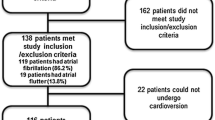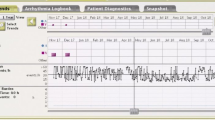Abstract
Purpose
P wave characteristics change during simulated apneic events in individuals with atrial fibrillation (AF). This study sought to assess whether similar changes occur during nocturnal respiratory events in patients with AF and obstructive sleep apnea (OSA).
Methods
Thirty-five individuals with severe OSA who underwent formal polysomnography and subsequent AF ablation were compared to a matched group without AF. Electrocardiographic segments from each polysomnogram corresponding to the following events were identified: period of wakefulness closest to the initial onset of sleep (baseline-awake), first respiratory event, respiratory event with the lowest nadir oxygen saturation, longest respiratory event, and last respiratory event. Signal-averaged P wave duration and signal-averaged positive P wave area (amplitude*duration for positive P wave amplitudes) were extracted using custom software. P wave characteristics during respiratory events and the baseline-awake condition were compared.
Results
Compared to the baseline-awake condition, the signal-averaged positive P wave area was significantly greater during the longest event and the event with the lowest oxygen saturation in those with AF, but not in those without AF. There were no significant differences in signal-averaged P wave duration for any respiratory event compared to the baseline-awake condition, regardless of AF status.
Conclusion
In patients with paroxysmal AF and obstructive sleep apnea, the signal-averaged positive P wave area is greater during certain respiratory events than during wakefulness. This finding may reflect the acute impact on right atrial volume of increased venous return associated with respiratory events and could be useful to assess AF risk in sleep apnea and to monitor response to treatment.



Similar content being viewed by others

References
Mehra R, Benjamin EJ, Shahar E, Gottlieb DJ, Nawabit R, Kirchner HL, Sahadevan J, Redline S, Sleep Heart Health Study (2006) Association of nocturnal arrhythmias with sleep-disordered breathing: the sleep heart health study. Am J Respir Crit Care Med 173:910–916
Monahan K, Storfer-Isser A, Mehra R, Shahar E, Mittleman M, Rottman J, Punjabi N, Sanders M, Quan SF, Resnick H, Redline S (2009) Triggering of nocturnal arrhythmias by sleep-disordered breathing events. J Am Coll Cardiol 54:1797–1804
Drager LF, McEvoy RD, Barbe F, Lorenzi-Filho G, Redline S (2017) Sleep apnea and cardiovascular disease: lessons from recent trials and need for team science. Circulation 136:1840–1850
Lau DH, Nattel S, Kalman JM, Sanders P (2017) Modifiable risk factors and atrial fibrillation. Circulation 136:583–596
Darbar D, Jahangir A, Hammill SC, Gersh BJ (2002) P wave signal-averaged electrocardiography to identify risk for atrial fibrillation. Pacing Clin Electrophysiol 25:1447–1453
Maeno K, Kasagi S, Ueda A, Kawana F, Ishiwata S, Ohno M, Yamaguchi T, Narui K, Kasai T (2013) Effects of obstructive sleep apnea and its treatment on signal-averaged P-wave duration in men. Circ Arrhythm Electrophysiol 6:287–293
Gaisl T, Wons AM, Rossi V, Bratton DJ, Schlatzer C, Schwarz EI, Camen G, Kohler M (2016) Simulated obstructive sleep apnea increases P-wave duration and P-wave dispersion. PLoS One 11:e0152994
Shoemaker MB, Muhammad R, Parvez B, White BW, Streur M, Song Y, Stubblefield T, Kucera G, Blair M, Rytlewski J, Parvathaneni S, Nagarakanti R, Saavedra P, Ellis CR, Patrick Whalen S, Roden DM, Darbar R. D (2013) Common atrial fibrillation risk alleles at 4q25 predict recurrence after catheter-based atrial fibrillation ablation. Heart Rhythm 10:394–400
Shoemaker MB, Muhammad R, Farrell M, Parvez B, White BW, Streur M, Stubblefield T, Rytlewski J, Parvathaneni S, Nagarakanti R, Roden DM, Saavedra P, Ellis C, Whalen SP, Darbar D (2013) Relation of morbid obesity and female gender to risk of procedural complications in patients undergoing atrial fibrillation ablation. Am J Cardiol 111:368–373
Goyal SK, Wang L, Upender R, Darbar D, Monahan K (2014) Severity of obstructive sleep apnea influences the effect of genotype on response to anti-arrhythmic drug therapy for atrial fibrillation. J Clin Sleep Med 10:503–507
Patel NJ, Wells QS, Huang S, Upender RP, Darbar D, Monahan K (2017) Relation of obstructive sleep apnea and a common variant at chromosome 4q25 to atrial fibrillation. Am J Cardiol 119:1387–1391
Ehlert FA, Steinberg JS (1995) The P wave signal-averaged ECG. J Electrocardiol 28:33–38
Conte G, Luca A, Yazdani S, Caputo ML, Regoli F, Moccetti T, Kappenberger L, Vesin JM, Auricchio A (2017) Usefulness of P-wave duration and morphologic variability to identify patients prone to paroxysmal atrial fibrillation. Am J Cardiol 119:275–279
Magnani JW, Williamson MA, Ellinor PT, Monahan KM, Benjamin EJ (2009) P wave indices: current status and future directions in epidemiology, clinical, and research applications. Circ Arrhythm Electrophysiol 2:72–79
Acknowledgements
The authors wish to thank Melissa Francis for expert assistance in obtaining the polysomnographic data.
Funding
This work was supported by CTSA award no. UL1TR000445 from the National Center for Advancing Translational Sciences.
Author information
Authors and Affiliations
Corresponding author
Ethics declarations
This study has been approved by the Vanderbilt Medical Center Institutional Review Board and has therefore been performed in accordance with the ethical standards laid down in the 1964 Declaration of Helsinki and its later amendments. The manuscript does not contain clinical studies.
Disclaimer
The contents for this work are solely the responsibility of the authors and do not necessarily represent official views of the National Center for Advancing Translational Sciences or the National Institutes of Health.
Conflict of interest
The authors declare that they have no conflict of interest.
Additional information
Publisher’s note
Springer Nature remains neutral with regard to jurisdictional claims in published maps and institutional affiliations.
Rights and permissions
About this article
Cite this article
Monahan, K., Hodges, E., Agrawal, A. et al. Signal-averaged P wave area increases during respiratory events in patients with paroxysmal atrial fibrillation and obstructive sleep apnea. Sleep Breath 23, 1275–1281 (2019). https://doi.org/10.1007/s11325-019-01823-5
Received:
Revised:
Accepted:
Published:
Issue Date:
DOI: https://doi.org/10.1007/s11325-019-01823-5



